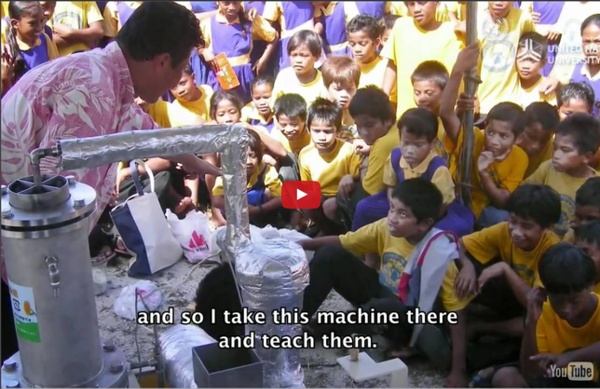



Plastic2oil - Converting Plastic to Oil Sungenis ya tiene la película En la próxima Primavera se va a proceder a anunciar al mundo científico un descubrimiento extraordinario, pero a diferencia de lo que suele ser habitual, esta vez no se utilizarán revistas especializadas sino una producción fílmica, cuyo titulo es “The Principle”, con todos los ingredientes espectaculares del más puro estilo Hollywood. La razón para este inusual anuncio es que todos los anteriores intentos de anunciar el descubrimiento, mediante artículos, publicaciones o libros divulgativos, han resultado más bien estériles pues han chocado con un muro inquebrantable erigido por el paradigma dominante, muy resistente a caer derribado. Veremos si son capaces de resistir a este embate. El productor ejecutivo de esta película, y documental científico es el americano Robert Sungenis, doctor en Teología y director de la Catholic Apologetic Internacional Publishing, y autor del libro “Galileo Was Wrong -The Church Was Right” que tanto hemos citado en este blog. ¡Agárrense! Bob Angelotti.
The Plastic Bank - Harvesting Waste Plastic to Reduce Poverty Thank you for helping us reach our goal. Our first campaign is over but another one will be coming soon. Please go to to join the Social Plastic movement. We are Leading the Social Plastic Movement! When we reveal value in plastic, it becomes too valuable to throw away and too valuable to leave sitting on a beach or in the ocean. Social Plastic is any plastic harvested by the poor and/or removed from an ocean, beach, or waterways. We are proudly leading the Social Plastic movement and we invite you to join the movement with your contributions. Our Solution to Reduce Poverty & Waste Plastic World Wide The Plastic Bank is setting up plastic repurposing centers around the world, where there’s an abundance of both waste plastic and poverty. We are helping people ascend from poverty by rewarding them for removing plastic waste from the land, oceans and waterways. Did We Mention We Can Recycle ANY Kind of Mixed Plastic You are a Big Part of the Solution Simply put.
Treehugger - From trash to treasure: Could non-recycled plastic be turned into a low-carbon fuel? As part of our efforts to diversify our energy sources, it's great to see the surge in interest and development of renewable energies such as solar and wind power, and innovations in tidal and wave power, but to really be able to reduce our use of fossil fuels, we might need to also explore some of our other options, such as using materials extracted from our waste streams as fuel. One emerging technology is working toward converting some of the non-marketable post-consumer plastics into a solid low-carbon fuel. While recycling of some plastics back into other materials makes sense for closing the loop on plastics a bit, until we can divert all recyclables from the waste stream, using some of it as an alternative fuel may be yet another way we can diversify our energy sources. "Although recycling rates have increased over the last few decades, more than 50% of our waste still ends up in landfills.
Instructables - Plastic Bottle Mosquito Trap Hello dear friends! As some of my followers already know, I live in Bologna (Italy), in the heart of Po river Valley. This area is known as the wettest one of Italy. This is due to terrain, level (a lot of areas are UNDER sea level) and weather. These factors result in very hot temperatures in summer, very cold ones in winter, an incredibly thick fog but, mostly, giant and aggressive mosquitoes. There is a city, Comacchio (only 55 miles from Bologna), that is known as the "Mosquitoes Town". Obviously is nothing tropical, but it's very annoying! It's really difficult to enjoy summer evenings without using pesticides, sprays or other stinky poisons. While mosquitoes are useful for the ecosystem (did you know that mosquitoes are the main cocoa plants pollinators? In this Instructable, I want to show you an all natural and potentially free way to create an efficent mosquito trap with little more than a plastic bottle! Why potentially free? Ready? Let's start with our shopping list.
Platified - Recyclage plastique Plastified.org from Sam Guillemette on Vimeo. Plastified.org propose des outils en libre partage servant à transformer, à l’échelle locale, du plastique rescapé du flux de la collecte sélective pour en faire du filament utilisable dans une imprimante 3D personnelle, appareil de plus en plus accessible. Cette hyperdémocratisation de la technologie 3D est au cœur du projet qui veut en réduire l’impact environnemental potentiellement très grand. Le plastique étant déjà un fardeau pour les infrastructures de gestion des déchets du monde entier, nous ne pouvons pas nous permettre de faire entrer dans nos foyers des machines qui augmenteront considérablement notre consommation de plastique et par le fait même, nos déchets. Ce site met donc à la disposition de tous le processus de fabrication d’une déchiqueteuse à plastique ainsi que d’une extrudeuse à filament pour imprimante 3D. Cette plateforme web permet aux futurs utilisateurs de nourrir et améliorer le projet suite à leurs expériences.
Humanosphere.info - Transformer 1kg de plastique en 1 litre de pétrole Japon – Plastique : Une société japonaise a créé une machine qui transforme des sacs en plastique en pétrole brut. Comment? En inversant le processus. Car si du pétrole peut fabriquer des sacs… le contraire est possible aussi. A ceci près que … … Que l’invention de Monsieur Akinori Ito de chez Blest corporation , peut transformer 1 kg de plastique en 1 litre de pétrole de manière beaucoup plus propre. Le procédé chauffe le plastique dans un lieu complètement étanche. Mieux! En savoir plus >>> Clic Clic Clic (Cela fait plusieurs fois que je réédite… mais si cette machine fonctionne… on peut vider les océans des déchets de plastique!!!!) transformer du plastique en petrole par alpharomano WordPress: J'aime chargement…
precious plastic - Recycled Plastic tools